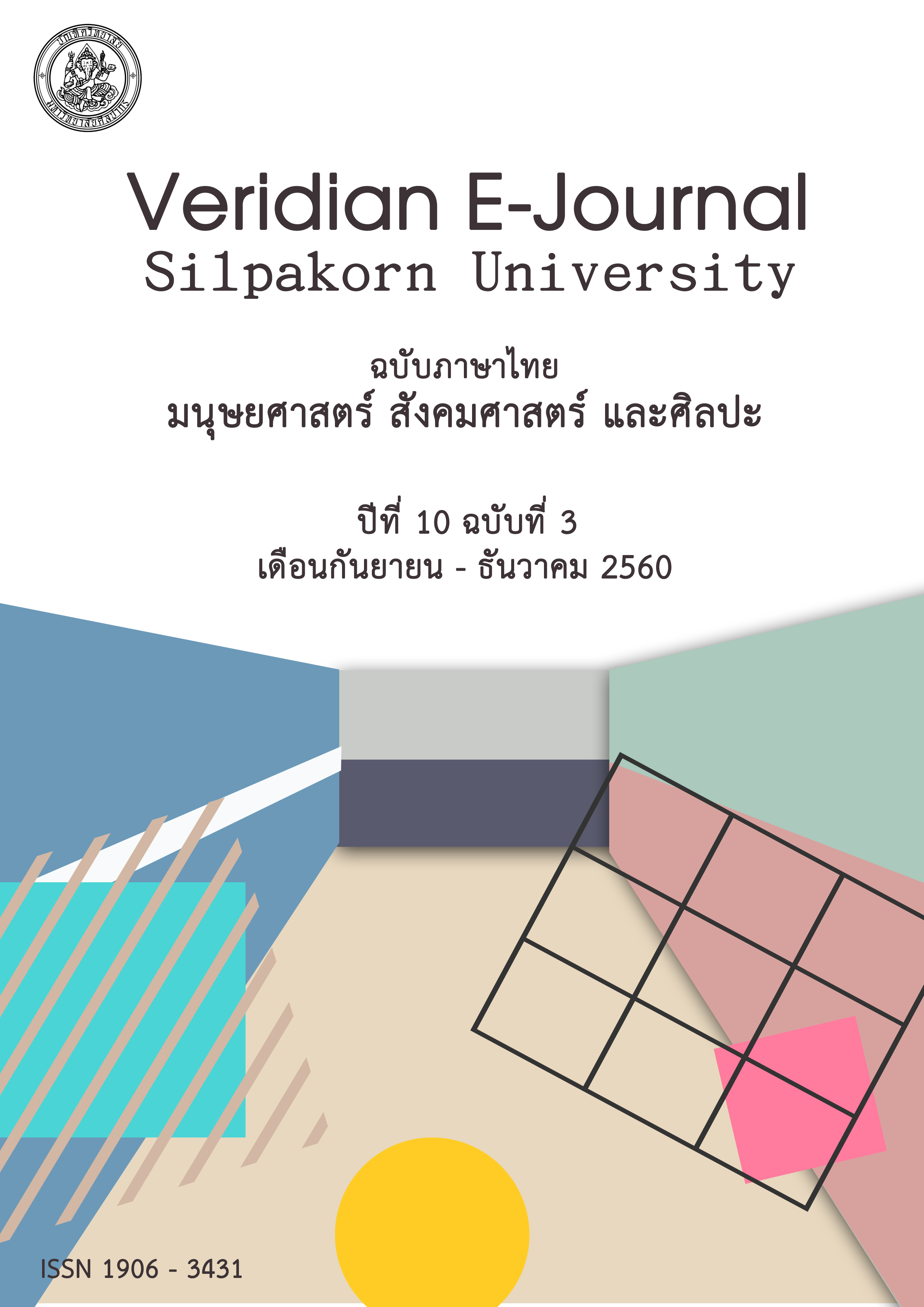การพัฒนากระบวนการเรียนรู้เพื่อเสริมสร้างจิตสำนึกรักษ์น้ำของเยาวชนคนกลาง น้ำคลองท่าแนะ จังหวัดพัทลุง
Main Article Content
Abstract
งานวิจัยนี้มีวัตถุประสงค์เพื่อ 1)สืบค้นภูมิปัญญาการอนุรักษ์น้ำของชุมชนคนกลางน้ำคลองท่าแนะ จังหวัดพัทลุง 2)พัฒนากระบวนการเรียนรู้เพื่อเสริมสร้างจิตสำนึกรักษ์น้ำของเยาวชนคนกลางน้ำคลองท่าแนะ จังหวัดพัทลุงและ 3)เสริมสร้างจิตสำนึกรักษ์น้ำของเยาวชนคนกลางน้ำคลองท่าแนะ จังหวัดพัทลุง กลุ่มเป้าหมายเป็นนักเรียนแกนนำเยาวชน จำนวน 15 คน เยาวชน จำนวน 95 คน จากสถานศึกษาในพื้นที่กลางน้ำ 3 โรงเรียน ได้แก่ โรงเรียนวัดไทรโกบ โรงเรียนวัดหรังแคบ และโรงเรียนวัดพิกุลทอง ที่ได้จากการเลือกแบบมีวัตถุประสงค์ เครื่องมือที่ใช้ในการวิจัย คือ 1) แผนการจัดกระบวนการเรียนรู้เพื่อเสริมสร้างจิตสำนึกรักษ์น้ำของเยาวชนคนกลางน้ำคลองท่าแนะ จังหวัดพัทลุง 2) แบบประเมินรับรองกระบวนการเรียนรู้เพื่อเสริมสร้างจิตสำนึกรักษ์น้ำของเยาวชนคนกลางน้ำคลองท่าแนะ จังหวัดพัทลุง 3) แบบวัดจิตสำนึกรักษ์น้ำ และ 4) แบบประเมินแบบวัดจิตสำนึกรักษ์น้ำ สถิติที่ใช้ในการวิจัย ได้แก่ ร้อยละ ค่าเฉลี่ย ส่วนเบี่ยงเบนมาตรฐาน และการทดสอบ wilcoxon signed-rank test.
ผลการวิจัย พบว่า 1) จากการสืบค้นภูมิปัญญาการอนุรักษ์น้ำของชุมชนคนกลางน้ำคลองท่าแนะ จังหวัดพัทลุงผ่านเรื่องเล่า พบว่า มีภูมิปัญญาเกี่ยวกับความเชื่อในเรื่องต่างๆ เช่น ผีพราย วังตุ่มพระ ผีไข่พอง
ทวดงู ตลอดจนความเชื่อเรื่องพ่อตาโพธิ์ และเมื่อพิจารณาตามวงความหมาย พบว่า ภูมิปัญญาของผู้คนในแถบนี้มีความเกี่ยวข้องสัมพันธ์ตามลำดับความสำคัญดังนี้ (1) สรรพสิ่ง (entities) ร้อยละ 51.35 (ธรรมชาติ อำนาจเหนือธรรมชาติ สิ่งมีชีวิตทั้งมนุษย์ คน สัตว์) (2) นามธรรม (abstracts) ร้อยละ 20.67 (ลักษณะทางศาสนา ความดี ความเลว เวลาสุขภาพ สถานภาพ) (3) เหตุการณ์ (events) ร้อยละ 17.57 (การสื่อสารการควบคุม การกระทำที่ซับซ้อน ลักษณะทางกายภาพ และความเป็นสมาคม) และ (4) ความสัมพันธ์ (relationals) ร้อยละ 10.40 (ตรรกะ ตำแหน่ง ระยะเวลา) ความเลว เวลาสุขภาพ สถานภาพ)
2) ผลการพัฒนากระบวนการเรียนรู้เพื่อเสริมสร้างจิตสำนึกรักษ์น้ำของเยาวชนคนกลางน้ำคลองท่าแนะ จังหวัดพัทลุง ผ่านการพิจารณาจากผู้เชี่ยวชาญด้านความเหมาะสม ความเป็นไปได้ ความชัดเจน และความง่ายต่อการนำไปใช้ ประกอบด้วย (1) แนวคิด (2) เป้าหมาย (3) เงื่อนไข(4) แผนการจัดกระบวนการเรียนรู้ของโรงเรียนพื้นที่ต้นน้ำ (5) การประเมินผล และ (6) การนำเสนอผลและวางแผนการปรับปรุงพัฒนา
3) ผลการเสริมสร้างจิตสำนึกรักษ์น้ำโดยใช้กระบวนการเรียนรู้เพื่อเสริมสร้างจิตสำนึกรักษ์น้ำของเยาวชนคนกลางน้ำคลองท่าแนะ จังหวัดพัทลุง พบว่า นักเรียนแกนนำและนักเรียนเยาวชนมีจิตสำนึกรักษ์น้ำแตกต่างกับเกณฑ์อย่างมีนัยสำคัญทางสถิติที่ระดับ .05
The purposes of this study were 1) to inquire the water conservation consciousness wisdom of basin community youths of Kon Klang Nam of Khlong Ta Nae, Phatthalung province. 2) to develop learning process enhancing water conservation consciousness of basin community youths of Kon Klang Nam Khlong Ta Nae, Phatthalung province. 3) to fulfill youths' awareness of enhancing water conservation. The samples of this study were 15 youth leader students and 95 youths from 3 schools of Klang Nam basin community: Wat Sai kop School, Wat lang Kab School and Wat Pikun Thong School using purposive sampling method. The research instruments were 1) learning process to enhance water conservation consciousness of a basin community youths of Kon Klang Nam of Khlong Ta Nae, Phatthalung province. 2) assessment form to affirm the learning process 3) test of water conservation consciousness 4) assessment form to affirm the water conservation consciousness. The statistic of data analysis were percentage, mean, standard deviation and Wilcoxon Signed-Rank Test.
The results were as follows: 1) The findings were that the community’s local wisdom on water conservation were related to various believes, such as, Pee Prai, Wung Toom Phra, Pee Khai Pong, Tuad Ngoo, Por Ta Poe. Four semantic domains of the local wisdom were found in sequence: 1) the entities (nature, creatures: human beings, plants and animals) were at 51.35% 2) the abstract (religious characteristic, goodness, devil, health and space ) were at 20.67% 3) the events (communication, control, the complex behavior, physical and the association) were at 17.57% and 4) the relations (logic, position and period) were at 10.40%.
2) The learning process for enhancing water conservation consciousness of basin community youths of Kon Klang Nam Khlong Ta Nae, Phattalung province were approved by experts in terms of appropriateness, possibility, distinctiveness and ease for implementation. There were six components in this learning process: (1) approach (2) goal (3) condition (4) learning process preparation (5) evaluation (6) result presentation and improvement.
3) The results of water conservation consciousness found that youth leader students' and youths' consciousness of conserving water at Khlong Ta Nae, Phattalung province were statistically significantly different at .05.
